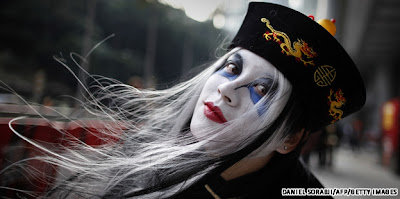El Capitan, Half Dome and Brideveil Fall. Photos by Tammy Yee.
Yosemite National Park ranks in my books as one of the ultimate family destinations. Ample restroom and dining facilities, an excellent bus system, and a multitude of activities sure to satisfy all levels of hikers, photographers and nature lovers alike, from the novice to the expert--all in a compact geographical area that features some of the most dramatic and beloved vistas in North America.
When we first planned our vacation in March of 2009, we were resigned to take a detour to the Wawona Entrance because of wintry road conditions. Fortunately, the National Park Service posts
up-to-date information on road closures in Yosemite, and we learned that just days before our trip, Highway 140 through Mariposa County was re-opened, allowing us to enter through the iconic Arch Rock Entrance (left).
It's advisable that you always check travel conditions in and out of the park, either through their
Road Status hotline (209/372-0200--press 1 then 1) or by tuning in to the
National Park Service radio station, posted on multiple signs along the route.
A little story about spring road conditions. We learned beforehand that we needed tire chains to enter the park, so we bought a set at the Pep Boys in Merced. The nice folks at Pep Boys patiently educated our clueless Hawaiian travel party, and were even nice enough to give us a full refund when we returned the chains, unopened and unused, at the end of our vacation.
A snowy Brideveil Fall greeted us upon our entrance into Yosemite National Park.
Three days later the snow had melted, and Brideveil Fall was shrouded in mist and rainbows.
However, Yosemite in the spring is well worth that minor inconvenience. We had three days of snow, followed by thawing that allowed us to view the park in both winter and spring conditions. AND, Badger Pass, the oldest downhill skiing area in California, was open for skiing and snowboarding! That was an unexpected treat. Though from the perspective of the ski lift operator who had to (groan) stop the lift twice for the dumb Hawaiian who couldn't dismount (me), perhaps it wasn't so much of a treat.
Mirror Lake is a great hike for young families. The first section of the hike is paved, and ends with bathroom facilities and a small, shallow pond where both kids and parents can take a break. Further in you'll find the reflective lake.
Reservations inside the park are available 366 days in advance and are strongly recommended, especially for the busy summer months.
We stayed in the
Yosemite Lodge at the Falls (right), which was not only conveniently located, but offered a spectacular view of Yosemite Falls as well as dining, internet access, gift shops, evening lectures and bus service throughout the park and up to Badger Pass...everything we needed to keep two 14-year-old boys occupied.
 |  |
Yosemite Falls: the Upper, Middle and Lower Falls, before and after the thaw. |
Aside from hiking, exploring and snowboarding, the park has several galleries and museums. The Yosemite Valley Visitor Center's exhibit hall features a free 23 minute film that documents the park's formation as well as an interactive display. Nearby is the Yosemite Museum, featuring the park's cultural history, with demonstrations of basket-weaving, beadwork and traditional games. And parents will enjoy the Ansel Adams Gallery.
Half Dome, from Sentinel Bridge.
One of our favorite family activities while visiting any national park is to collect photos of whatever wildlife we see--birds, mammals, reptiles, amphibians an even insects--then to identify and compile a list which my boys can later compare to park guides. At Yosemite, there's no shortage of animals.
Stellar's Jay.
Of course, in any encounter, children should be taught to not approach or feed the wildlife. The park offers information about what to do if you encounter a bear, and there are strict rules about food left in cars...a challenge with children, even without the bear factor. Food, and any item associated with food handling (used containers, food wrappers, utensils, cups, crumbs, used napkins), or with aromas that may be mistaken for food (soaps, cosmetics), may only be kept in cars during the day if they are stored out of sight, with the windows completely closed. After dark, food may not be kept in your car, and should be stored in a food locker, available at the Curry Village parking lot or at many of the trailhead parking areas.
Be sure to visit the Yosemite National Park (U.S. National Park Service) web site before planning your family vacation. There you'll find important safety tips and weather updates, as well as animal species lists and information about many of the park's attractions and programs.
Entrance Fees:
$20 per private car or $10 per person arriving on foot, horseback, bicycle, motorcycle, or on a non-commercial bus or passenger van (free for those 15 years old and younger).
Hours of Operation:
Open 24 hours per day, 365 days per year, however the Hetch Hetchy Entrance Station operates only during daylight hours, and some roads may be closed due to snow from November to May. Check
road conditions before visiting in the winter. No reservations are needed if you are visiting; however, reservations are essential if you are
lodging or
camping overnight.
El Capitan, breathtaking in the early morning light. Photos by Tammy Yee.
Fun Facts:

Wildlife
There are more than 400 animal species in Yosemite! This includes vertebrates (animals with backbones) such as mammals, birds, reptiles, amphibians and fish, as well as invertebrates (animals without backbones) such as insects, worms and snails. We carry an inexpensive pocket guide when visiting national parks. The plastic identification cards are compact and sturdy, great for younger children; while the pocketbook guides are great for older children.
Remember that however cute and cuddly they may appear, the animals are wild and should not be approached, harassed or fed.
©2010 Tammy Yee.
































































